|
Historic outline of marble usage in Tunisia :
Tunisia has been famous for its marble rocks since the Roman time (146 BC.). During this period, hundreds of towns were built using marble rocks extracted from the Tunisian soil. The Roman ruins extremely present in Tunisia as well as the remains of the ancient careers, which surround those towns, do witness the importance of the marble rocks in the urban activity of the Roman time.
The return to the local marble rocks started with the urban development that Tunisia has witnessed since the 1970s, especially in the hotel and high-standard building construction. This way, the marble-rock production has been developing from one year to another, and the Tunisian marble started to capture several foreign markets.
Carbonates in Tunisia:
Marble, in the very meaning of the term, does not exist in Tunisia. However, the carbonates that are transformed diagenetically, which have a good polish and color, were resembled to marbles and were highly appreciated in Tunisia as well as in the foreign countries. Thus, the term “marble rocks“ was coined.
These rocks were classified in accordance to their petrographic characteristics which made the acquaintance of the nature of the rock constituents and led to the identification of the different existing porosities as well as the physico-mechanic characteristics that permitted the identification of the density, specific weight, the porosity-absorption percentage, resistance to compression, to wear and fragmentation. The way the marble rocks are utilized is defined throughout their geotechnical characteristics.
The geological periods that are reach in marble rocks in Tunisia
From a geological standpoint, the potential zones belong at least to three periods characterized by sedimentologic and paleographic conditions that are markedly different from each other :
-
The Jurassic era delivered marbles of diversified colors :
- Gray and black, Aziza type, within Aziza massifs, Raouas and Oust.
- Yellow and reddish, Chemtou type, especially in Hairech massif.
- Beige and reach in bioclast, Ghomrassenn type, very widespread in Tataouine region.
-
The Cretaceous era, is marked by marble rocks of diversified colors :
- Black, Boulahneche type, of albo-aptien.
- Shade of grayish beige and carbonates of Gattar bar of a Turonien age, which made a good landmark in the south of Tunisia. Those marbles are to be promoted under the name Matmata.
- Whitish, pink, red and yellowish, Keddel type of a cenomanien age.
- Grayish beige of Thala type dating from the inferior campano-maastricht. The latter is found frequently in Central Tunisia and central north.
-
The lower Eocene with its facies of nummulite limestone, provided marbles with the following characteristics :
- Beige, whitish, gray and black of Kesra type.
- Pinkish yellow of Mateur.
The carbonates of these three long periods present the characteristics of marble rocks :
-
The Jurassic : provided marble rocks with the various colors.
- Gray and black of Aziza, Raouas, and Lias types in the Tunisian ridge,
- Reddish yellow of Chemtou type in the region of Ghar Dimaou,
- Beige and riche in bioclast, of Oxfordian Ghomrasséne in the south of Tunisia.
-
The cretaceous : is marked by marble rocks with a variety of colors :
- Black of a Boulahnéche type of an albo-aptien age known in the Tunisian ridge,
- Shade of grayish beige of Matmata if the Gattar bar, which a turonien age in the south of Tunisia,
- Whitish, pink, yellowish red and gray of Keddel type, which is of a cenomanien age, found in Tunisia’s outskirts.
-
The Eocene :
is marked by facies of nummulite limestone of the “Ypresien”.
The rock gave in this level whitish beige, gray and black colors of Kesra type.
These limestones are found considerably in central Tunisia. This type also extends to different facies of the Eocene and particularly to the pinkish-yellow facies of Mateur.
... For further information
|
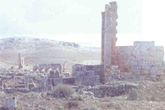
A Roman town constructed in M’Deina with local marble rocks
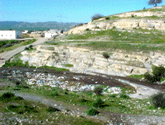
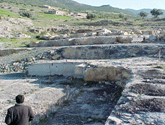
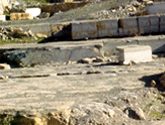
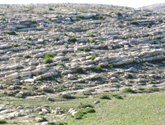
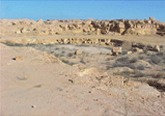
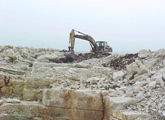
The stratigraphic series of Tunisia are essentially sedimentary
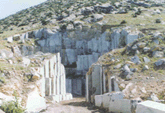
View of a career in J.Aziza at the level of M’Cherga.
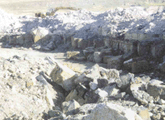
Career in J. Boulahnéche of an albien age, formed by an alternation of limestone bars and marl.
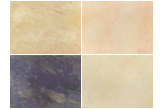
- Polished plate of the beige gray variety that is rich in nummulite, which is extracted from J.Ebba.
- Polished plate of the black variety of Kesra (base of the nummullite plate)
- Polished plate of the pinkish-yellow variety, extracted from the Mateur Eocene.
- Polished plate of the beige variety, extracted from slab base in J. Ebba.
|



